Related Research Articles
Eridu was a Sumerian city located at Tell Abu Shahrain, also Abu Shahrein or Tell Abu Shahrayn, an archaeological site in southern Mesopotamia. It is located in Dhi Qar Governorate, Iraq near the modern city of Basra. Eridu is traditionally believed to be the earliest city in southern Mesopotamia based on the Sumerian King List. Located 12 kilometers southwest of the ancient site of Ur, Eridu was the southernmost of a conglomeration of Sumerian cities that grew around temples, almost in sight of one another. The city gods of Eridu were Enki and his consort Damkina. Enki, later known as Ea, was considered to have founded the city. His temple was called E-Abzu, as Enki was believed to live in Abzu, an aquifer from which all life was believed to stem. According to Sumerian temple hymns another name for the temple of Ea/Enki was called Esira (Esirra).
"... The temple is constructed with gold and lapis lazuli, Its foundation on the nether-sea (apsu) is filled in. By the river of Sippar (Euphrates) it stands. O Apsu pure place of propriety, Esira, may thy king stand within thee. ..."
Uruk, today known as Warka, was a city in the ancient Near East situated east of the present bed of the Euphrates River on the dried-up ancient channel of the Euphrates. The site lies 93 kilometers northwest of ancient Ur, 108 kilometers southeast of ancient Nippur and 24 kilometers southeast of ancient Larsa. It is 30 km (19 mi) east of modern Samawah, Al-Muthannā, Iraq.

Cuneiform proper is a logo-syllabic script that was used to write several languages of the Ancient Near East. The script was in active use from the early Bronze Age until the beginning of the Common Era. Cuneiform scripts in general are marked by and named for the characteristic wedge-shaped impressions which form their signs. Cuneiform is the earliest known writing system and was originally developed to write the Sumerian language of southern Mesopotamia.
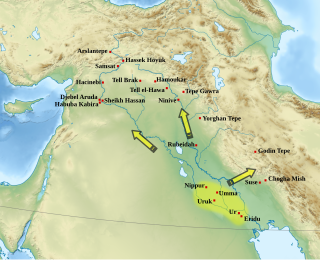
The Uruk period existed from the protohistoric Chalcolithic to Early Bronze Age period in the history of Mesopotamia, after the Ubaid period and before the Jemdet Nasr period. Named after the Sumerian city of Uruk, this period saw the emergence of urban life in Mesopotamia and the Sumerian civilization. The late Uruk period saw the gradual emergence of the cuneiform script and corresponds to the Early Bronze Age; it has also been described as the "Protoliterate period".

Anshan modern Tall-e Malyan, also Tall-i Malyan, was an Elamite and ancient Persian city. It was located in the Zagros Mountains in southwestern Iran, approximately 46 kilometres (29 mi) north of Shiraz and 43 kilometres (27 mi) west of Persepolis in the Beyza/Ramjerd plain, in the province of Fars.

The Proto-Elamite period, also known as Susa III, is a chronological era in the ancient history of the area of Elam, dating from c. 3100 BC to 2700 BC. In archaeological terms this corresponds to the late Banesh period. Proto-Elamite sites are recognized as the oldest civilization in the territory of present-day Iran. The Proto-Elamite script is an Early Bronze Age writing system briefly in use before the introduction of Elamite cuneiform.

The Proto-Elamite script is an Early Bronze Age writing system briefly in use before the introduction of Elamite cuneiform.

Jemdet Nasr is a tell or settlement mound in Babil Governorate (Iraq) that is best known as the eponymous type site for the Jemdet Nasr period, and was one of the oldest Sumerian cities. The site was first excavated in 1926 by Stephen Langdon, who found Proto-Cuneiform clay tablets in a large mudbrick building thought to be the ancient administrative centre of the site. A second season took place in 1928, but this season was very poorly recorded. Subsequent excavations in the 1980s under British archaeologist Roger Matthews were, among other things, undertaken to relocate the building excavated by Langdon. These excavations have shown that the site was also occupied during the Ubaid, Uruk and Early Dynastic I periods. Based on texts found there mentioning an ensi of NI.RU that is thought to be its ancient name.
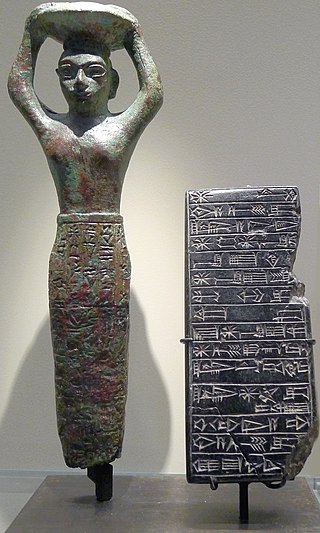
Amar-Sin, initially misread as Bur-Sin was the third ruler of the Ur III Dynasty. He succeeded his father Shulgi. His name translates to 'bull calf of the moon-god'.

Linear Elamite was a writing system used in Elam during the Bronze Age between c. 2300–1850 BCE, and known mainly from a few extant monumental inscriptions. It was used contemporaneously with Elamite cuneiform and records the Elamite language. The French archaeologist François Desset and his colleagues have argued that it is the oldest known purely phonographic writing system, although others, such as the linguist Michael Mäder, have argued that it is partly logographic.

Denise Schmandt-Besserat is a French-American archaeologist and retired professor of art and archaeology of the ancient Near East. She spent much of her professional career as a professor at the University of Texas. She is best known for her work on the history and invention of writing. While her research is highly cited, it has been controversial among scholars. The controversies, as detailed below, concern the interpretation of early tokens, particularly the complex ones; however, the idea that writing emerged out of the counting, cataloging, management, and transactions of agricultural produce has been largely accepted.
Number systems have progressed from the use of fingers and tally marks, perhaps more than 40,000 years ago, to the use of sets of glyphs able to represent any conceivable number efficiently. The earliest known unambiguous notations for numbers emerged in Mesopotamia about 5000 or 6000 years ago.
Tapeh Yahya is an archaeological site in Kermān Province, Iran, some 220 kilometres (140 mi) south of Kerman city, 90 kilometres (56 mi) south of Baft city and 90 km south-west of Jiroft. The easternmost occupation of the Proto-Elamite culture was found there.
Tell Uqair is a tell or settlement mound northeast of Babylon and about 50 miles (80 km) south of Baghdad in modern Babil Governorate, Iraq.
Tell Billa is an archaeological site near Bashiqa in Nineveh Province (Iraq) 20 kilometers northeast of Mosul. Beginning in Middle Assyrian times the ancient city, not far from Assur, was named Shibaniba. Its earlier name is not known. In 2022 it was proposed that Tell Billa was the site of the Ur III period Hurrian city Šimānum.
The Cuneiform Digital Library Initiative (CDLI) is an international digital library project aimed at putting text and images of an estimated 500,000 recovered cuneiform tablets created from between roughly 3350 BC and the end of the pre-Christian era online. Directors of the project are Robert Keith Englund from University of California, Los Angeles and Jürgen Renn of the Max Planck Institute for the History of Science. Co-principal investigators are Jacob Dahl at Oxford University, Bertrand Lafront at the Centre national de la recherche scientifique, Nanterre and Émilie Pagé-Perron, University of Toronto. Preceding leadership comprised co-director Peter Damerow (1939–2011) from the Max Planck Institute for the History of Science and Pennsylvania Sumerian Dictionary leader Stephen J. Tinney who was co-principal investigator. In 2004, Englund received the Richard W. Lyman Award from the National Humanities Center for his work on the initiative.
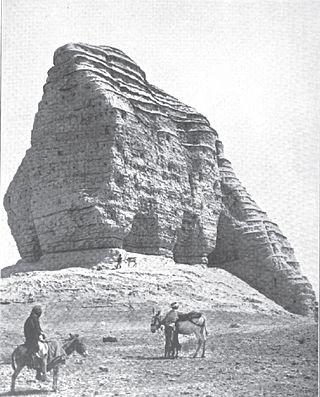
Kurigalzu I, usually inscribed ku-ri-gal-zu but also sometimes with the m or d determinative, the 17th king of the Kassite or 3rd dynasty that ruled over Babylon, was responsible for one of the most extensive and widespread building programs for which evidence has survived in Babylonia. The autobiography of Kurigalzu is one of the inscriptions which record that he was the son of Kadašman-Ḫarbe. Galzu, whose possible native pronunciation was gal-du or gal-šu, was the name by which the Kassites called themselves and Kurigalzu may mean Shepherd of the Kassites.
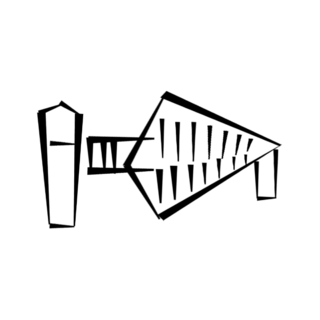
Kushim is supposedly the earliest known recorded name of a person in writing. The name "Kushim" is found on several Uruk period clay tablets used to record transactions of barley. It is uncertain if the name refers to an individual, a generic title of an officeholder, or an institution.
The proto-cuneiform numerals are one of the most complex systems of enumeration in any early writing system. Their decipherment took place over several phases in the 20th century, including major advances in Adam Falkenstein’s 1936 signlist, followed by specific studies by Jöran Friberg and A. A. Vajman, and ultimately the identification and decipherment of fifteen distinct subsystems of enumeration in the collaborative efforts of Peter Damerow and Robert Keith Englund in the 1980s as part of the Archaische Texte aus Uruk project.
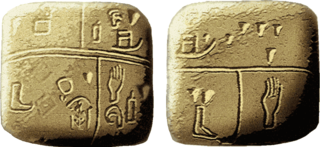
The proto-cuneiform script was a system of proto-writing that emerged in Mesopotamia, eventually developing into the early cuneiform script used in the region's Early Dynastic I period. It arose from the token-based system that had already been in use across the region in preceding millennia. While it is known definitively that later cuneiform was used to write the Sumerian language, it is still uncertain what the underlying language of proto-cuneiform texts were.
References
- ↑ "Robert K. Englund". Cuneiform Digital Library Initiative .
- ↑ Englund, Robert K. (1990). Organisation und Verwaltung der Ur III-Fischerei. D. Reimer. ISBN 9783496003892.
- ↑ Carter, Anna Rose (June 10, 2018). "Retiring professors leave behind legacy of passion for Near Eastern archaeology". Daily Bruin .
- ↑ "| TeamQuantum Photonics Laboratory | RLE at MIT". qp.mit.edu. Retrieved November 30, 2023.
- ↑ "Tributes: Bob Englund". June 5, 2020.
- ↑ "Archaische Texte aus Uruk (Irak)". October 17, 2007.
- ↑ "Excavations at Tepe Yahya, Iran, 1967-1975, Volume II: The Proto-Elamite Texts from Tepe Yahya — Peter Damerow, Robert K. Englund".
- ↑ Englund, R. K. (2009). "The Smell of the Cage 1" (PDF). S2CID 6714012.
{{cite journal}}: Cite journal requires|journal=(help) - ↑ "Publications". Cuneiform Digital Library Initiative .
- ↑ "Web library assembling ancient written documents". usatoday30.usatoday.com. May 17, 2002. Archived from the original on August 28, 2020.
- ↑ Cuneiform Digital Library Initiative
- ↑ Estrin, Daniel (February 13, 2015). "Archäologie: Streit über Schrifttafeln in Jerusalemer Ausstellung". Die Welt.
- ↑ "Machine assisted translation of cuneiform texts". Cuneiform Digital Library Initiative . April 3, 2017.
- ↑ Nissen, Hans J.; Damerow, Peter; Englund, Robert K. (2004). Informationsverarbeitung vor 5000 Jahren: Frühe Schrift und Techniken der Wirtschaftsverwaltung im alten Vorderen Orient ; Informationsspeicherung und -verarbeitung vor 5000 Jahren ; [Begleitpublikation zur Ausstellung "Frühe Schrift und Techniken der Wirtschaftsverwaltung im Alten Vorderen Orient" des Seminars für Vorderasiatische Altertumskunde der Freien Universität Berlin in Zusammenarbeit mit dem Forschungsbereich Entwicklung und Sozialisation des Max-Planck-Instituts für Bildungsforschung und dem Museum für Vor- und Frühgeschichte der Staatlichen Museen Preußischer Kulturbesitz, die im Museum für Vor- und Frühgeschichte, Berlin-Charlottenburg, vom 16. Mai bis 29. Juli 1990 stattfand]. ISBN 3881204008.
- ↑ Nissen, Hans J.; Damerow, Peter; Englund, Robert K. (1993). Archaic Bookkeeping: Early Writing and Techniques of Economic Administration in the Ancient Near East. University of Chicago Press. ISBN 978-0-226-58659-5.
- ↑ "Cdli tablet". Cuneiform Digital Library Initiative .
- 1 2 "cdli tablet". apps.apple.com.
- ↑ ""cdli tablet" joins the Android family". Cuneiform Digital Library Initiative . October 18, 2017.
- ↑ Englund, Robert K. "ORGANISATION UND VERWALTUNG DER UR lli-FISCHEREI" (PDF).
- ↑ Englund, Robert K. "Texts from the Late Uruk Period" (PDF).
- ↑ Bauer, Josef; Englund, Robert K.; Krebernik, Manfred (1998). "Mesopotamien: Späturuk-Zeit und Frühdynastische Zeit". Orbis Biblicus et Orientalis. 160/1. doi:10.5167/uzh-151545.
- ↑ Damerow, Peter; Englund, Robert K. "The Proto-Elamite Texts from Tepe Yahya" (PDF).
- ↑ Nissen, Hans J.; Damerow, Peter; Englund, Robert K.; Englund, Robert K. (1993). Archaic Bookkeeping: Early Writing and Techniques of Economic Administration in the Ancient Near East. University of Chicago Press. ISBN 9780226586595.